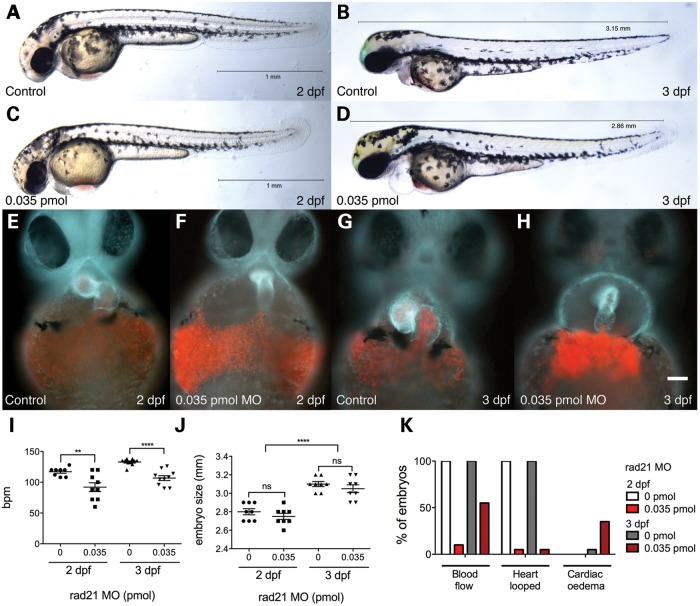Figure 2.
Cardiac phenotypes in Rad21-depleted embryos. Zebrafish embryos were injected at the one-cell stage with 1 nl phenol red dye, or with 0.035 pmol Rad21 ATG MO, then raised as described below. (A and B) Control embryos and (C and D) Rad21-depleted embryos at 2 and 3 dpf. Rad21-depleted embryos incubated at 28.5°C were equivalent in size to controls incubated at 25°C. Apart from cardiac defects, Rad21-depleted embryos displayed no obvious malformations. (E–H) Heart morphology at 2 and 3 dpf, visualized using a double-transgenic Tg(gata1:dsred), Tg(β-actin:GFP) zebrafish line, in which erythrocytes are labeled red, and myocardium is light blue. Scale bar is 50 µm. (F and H) At both 2 and 3 dpf, the hearts of Rad21-depleted embryos failed to loop, and blood cells accumulated under the heart. n > 12 for each condition. (I) Heart rate in beats per minute (bpm) at 2 and 3 dpf. Heart rate was significantly reduced in Rad21-depleted embryos at both 2 and 3 dpf (**P < 0.01 and ****P < 0.0001, respectively, unpaired t-test). Error bars are ±SEM. (J) Embryo size at 2 and 3 dpf. There was no difference in size at either time point between Rad21-depleted and control embryos, when controls were grown at 25°C and Rad21-depleted embryos at 28°C (P > 0.05, unpaired t-test). Three days post-fertilization embryos were significantly larger than 2 dpf (****P < 0.0001, two-way unpaired ANOVA). Error bars are ±SEM. (K) Phenotypic abnormalities observed at 2 and 3 dpf. Rad21-depleted embryos had reduced blood flow and unlooped hearts at 2 and 3 dpf, as well as cardiac edema at 3 dpf (see also Supplementary Material, Video S2).

